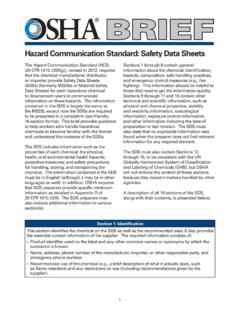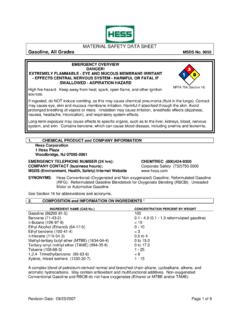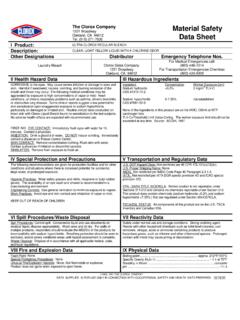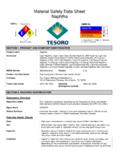Transcription of USED OIL MATERIAL SAFETY DATA SHEET - Cranesville
1 Revision 9/07; msds Form No. 81451 - Page 1 of 10 USED OIL MATERIAL SAFETY data SHEET SECTION 1: PRODUCT AND COMPANY IDENTIFICATION PRODUCT NAME: USED OIL SYNONYMS: Waste oil; Used lubricating oil; Oil and water mixture PRODUCT PART NUMBER(S): Not applicable. PRODUCT USE: Oil or water mixture for re-refining or reprocessing. If this product is used in combination with other products, refer to the MATERIAL SAFETY data Sheets for those products. 24-HOUR EMERGENCY PHONE NUMBERS These numbers are for MEDICAL AND TRANSPORTATION (SPILL): emergency use only. If you desire non-emergency 1-800-468-1760 product information, please call a phone number listed below.
2 MANUFACTURER/ SUPPLIER: SAFETY -Kleen Systems, Inc. 5400 Legacy Drive Cluster II, Building 3 Plano, Texas 75024 USA 1-800-669-5740 TECHNICAL INFORMATION: 1-800-669-5740 Press 1 then 1 then Extension 7500 msds FORM NUMBER: 81451 ISSUE: September 20, 2007 ORIGINAL ISSUE: January 15, 1990 SUPERSEDES: June 11, 2007 PREPARED BY: Product msds Coordinator APPROVED BY: msds Task Force USED OIL MATERIAL SAFETY data SHEET Revision 9/07; msds Form No. 81451 - Page 2 of 10 SECTION 2: COMPOSITION/INFORMATION ON INGREDIENTS OSHA PEL ACGIH TLV WT% NAME SYNONYM CAS NO. TWA STEL TWA STEL LDa LCb 80 to 100 Lubricating oils, used Used oil 70514-12-4 N.
3 Av. N. Av. N. Av. N. Av. N. Av. N. Av. 0 to 20* Water/solids N. Av. N. Av. N. Av. N. Av. N. Av. N. Av. N. Av. N. Av. 0 to 10* Hydrocarbon solvents. May include gasoline, diesel fuel, jet fuel, mineral spirits, etc. N. Av. N. Av. N. Av. N. Av. N. Av. N. Av. N. Av. N. Av. 0 to * Metals. May include lead, iron, zinc, copper, chromium, arsenic, nickel, and others: each below WT%. N. Av. N. Av. N. Av. N. Av. N. Av. N. Av. N. Av. N. Av. 0 to * Polynuclear aromatics. May include naphthalene, fluoranthene, phenanthrene, pyrene, and others: each below WT%. N. Av. N. Av. N. Av. N. Av. N. Av. N. Av. N. Av. N. Av. 0 to * Chlorinated solvents. N. Av.
4 N. Av. N. Av. N. Av. N. Av. N. Av. N. Av. N. Av. = Not Available *Even though the concentration range does not fall under the ranges prescribed by WHMIS, this is the actual range which varies with each batch of the product. aOral-Rat LD50 (mg/kg) bInhalation-Rat LC50 SECTION 3: HAZARDS IDENTIFICATION EMERGENCY OVERVIEW APPEARANCE Liquid, black and viscous (thick), petroleum odor. WARNING! PHYSICAL HAZARDS Combustible liquid. HEALTH HAZARDS May be harmful if inhaled. May be harmful if absorbed through skin. May be harmful or fatal if swallowed. May irritate the respiratory tract (nose, throat, and lungs), eyes, and skin. Suspect cancer hazard. Contains MATERIAL which can cause cancer.
5 Risk of cancer depends on duration and level of exposure. Contains MATERIAL which can cause birth defects. Contains MATERIAL which can cause central nervous system damage. ENVIRONMENTAL HAZARDS Product may be toxic to fish, plants, wildlife, and/or domestic animals. USED OIL MATERIAL SAFETY data SHEET Revision 9/07; msds Form No. 81451 - Page 3 of 10 POTENTIAL HEALTH EFFECTS Effects may vary depending on MATERIAL composition. Typical effects may include: INHALATION High concentrations of vapor or mist may be harmful if inhaled. High (BREATHING): concentrations of vapor or mist may irritate the respiratory tract (nose, throat, and lungs). High concentrations of vapor or mist may cause nausea, vomiting, headaches, dizziness, loss of coordination, numbness, and other central nervous system effects.
6 Massive acute overexposure may cause rapid central nervous system depression, sudden collapse, coma, and/or death. EYES: May cause irritation. SKIN: May cause irritation. Product may be absorbed through the skin and cause harm as noted under INHALATION (BREATHING). INGESTION May be harmful or fatal if swallowed. May cause throat irritation, (SWALLOWING): nausea, vomiting, and central nervous system effects as noted under INHALATION (BREATHING). Breathing product into the lungs during ingestion or vomiting may cause lung injury and possible death. MEDICAL CONDITIONS Individuals with pre-existing cardiovascular, liver, kidney, AGGRAVATED BY respiratory tract (nose, throat, and lungs), central nervous EXPOSURE: system, eye, and/or skin disorders may have increased susceptibility to the effects of exposure.
7 CHRONIC: Prolonged or repeated inhalation may cause oil pneumonia, lung tissue inflammation, fibrous tissue formation, and/or toxic effects as noted under INHALATION (BREATHING). Prolonged or repeated eye contact may cause inflammation of the membrane lining the eyelids and covering the eyeball (conjunctivitis). Prolonged or repeated skin contact may cause drying, cracking, redness, itching, and/or swelling (dermatitis). CANCER This product contains mineral oils, untreated or mildly treated, which can INFORMATION: cause cancer. This product may contain hydrocarbon and chlorinated solvents; metals, and polynuclear aromatics which can cause cancer. Risk of cancer depends on duration and level of exposure.
8 For more information, see SECTION 11: CARCINOGENICITY. POTENTIAL ENVIRONMENTAL EFFECTS Product may be toxic to fish, plants, wildlife, and/or domestic animals. Also see SECTION 12: ECOLOGICAL INFORMATION. USED OIL MATERIAL SAFETY data SHEET Revision 9/07; msds Form No. 81451 - Page 4 of 10 SECTION 4: FIRST AID MEASURES INHALATION: Remove to fresh air. If not breathing, give artificial respiration. If breathing (BREATHING) is difficult, give oxygen. Oxygen should only be administered by qualified personnel. Someone should stay with victim. Get medical attention if breathing difficulty persists. EYES: If irritation or redness from exposure to vapor develops, move away from exposure into fresh air.
9 Upon contact, immediately flush eyes with plenty of lukewarm water, holding eyelids apart, for 15 minutes. Get medical attention. SKIN: Remove affected clothing and shoes. Wash skin thoroughly with soap and water. Get medical attention if irritation or pain develops or persists. INGESTION: Do NOT induce vomiting. Immediately get medical attention. Call (SWALLOWING) 1-800-468-1760 for additional information. If spontaneous vomiting occurs, keep head below hips to avoid breathing the product into the lungs. Never give anything to an unconscious person by mouth. NOTE TO Treat symptomatically and supportively. Treatment may vary with condition PHYSICIANS: of victim and specifics of incident.
10 Call 1-800-468-1760 for additional information. SECTION 5: FIRE FIGHTING MEASURES FLASH POINT: >200 F (93 C) (minimum) Pensky-Martens Closed Cup FLAMMABLE LIMITS IN AIR: Not available. AUTOIGNITION TEMPERATURE: Not available. HAZARDOUS COMBUSTION Decomposition and combustion materials may be toxic. PRODUCTS: Burning may produce phosgene gas, nitrogen oxides, carbon monoxide, and unidentified organic compounds. CONDITIONS OF FLAMMABILITY: Heat, sparks, or flame. Product may burn but does not ignite readily. EXTINGUISHING MEDIA: Use carbon dioxide, regular foam, dry chemical, water spray, or water fog.









